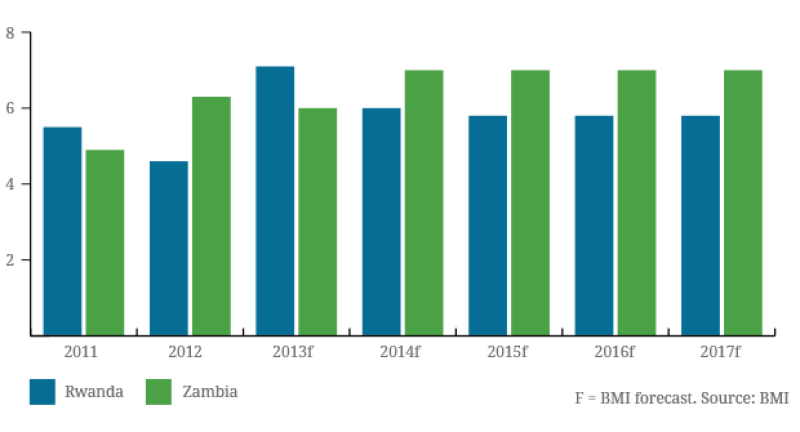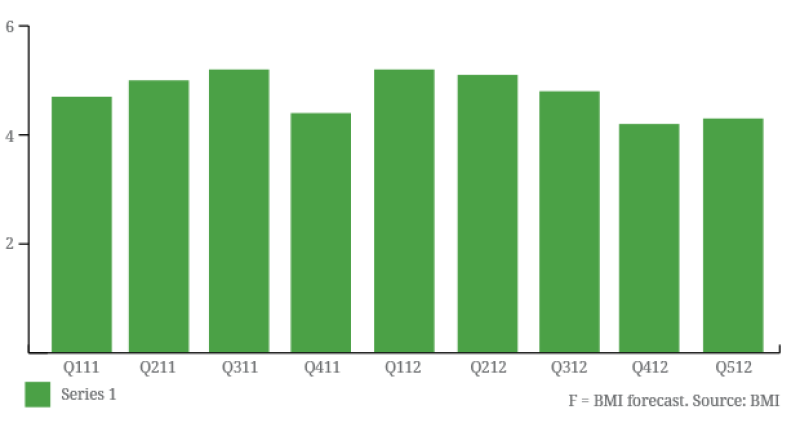BMI view
South Africa and Nigeria are MTN’s biggest markets by a wide margin, in terms of both revenue and subscriptions. For the six months ended June 2013, the countries accounted for 65% of MTN’s consolidated revenue and 40% of its total subscriber base. These factors, along with other market dynamics, including the presence of multiple international players and the volume of economic activity, make MTN’s tower assets in South Africa and Nigeria the most attractive for investors. However, it appears the operator is biding its time in making a move to outsource its tower infrastructure in both markets. This shifts attention to MTN’s remaining ten markets in Africa. Of these markets, BMI believes Rwanda and Zambia will appeal most to investors.
MTN’s tower deals in Cameroon and Cóte d’Ivoire underscore the company’s inclination towards tower outsourcing, where possible, across its African subsidiaries. Prior to the deal with IHS Towers in October 2012, MTN had executed tower sale and leaseback deals with American Tower Corp. (ATC) in Ghana in December 2010 and in Uganda a year later. MTN has expressed satisfaction with the positive effect of its tower deals on the bottom line performance of its units in the four countries. This will encourage the operator to implement a similar strategy in the other countries it is present in the region, creating significant growth opportunities for tower investors in those markets.
Rwanda And Zambia are good bets
As investors wait for MTN’s move in its prime markets, there are considerable opportunities in some of the operator’s smaller markets. Two countries that stand out in the small operations cluster, as classified by MTN, are Rwanda and Zambia. There have been media reports of MTN’s intention to jointly sell around 1,500 towers in both markets. Although these reports were yet to be confirmed at the time of writing, BMI’s assessment of the countries’ macroeconomic indicators and telecoms market dynamics points to strong growth potential for tower outsourcing. We believe MTN’s tower outsourcing strategy could soon open both markets to investment by independent tower firms and other stakeholders in the entire tower value chain.
In positive territory - real private consumption growth (%)

Annual economic growth in Rwanda averaged 8.2% between 2000 and 2012 and poverty has been significantly reduced. In Zambia, growth is driven by rising exports and diversification of the economic base. BMI is forecasting economic growth of 7.4% in 2013, a slight improvement on the already impressive real GDP expansion of 7.3% in 2012. On the downside, the two countries are landlocked and predominantly rural, with 77% of Rwanda’s population and 63% of Zambia’s population living in rural areas.
With respect to the telecoms sector, Rwanda and Zambia boast the presence of multiple international operators, including Airtel which competes with MTN in both markets. The main risk associated with the two countries is the high cost of infrastructure rollout and maintenance owing to their geographical locations and poor social infrastructure in rural areas.
Meanwhile, recent developments in Rwanda and Zambia suggest that both markets are ready for third-party tower-sharing services. Some of these are highlighted in the overviews of the market dynamics in both countries below.
Rwanda: price competition and coverage targets call for tower sharing
Rwanda’s mobile market hosts three international operators - MTN, Tigo and Airtel. MTN is the dominant player with a market share of 56.1% at the end of Q213, although this has been trending downwards since mid-2012 owing to increased competition. Airtel’s arrival fuelled further price competition in the market, but did not significantly improve subscriptions growth as the market recorded double-digit growth in just one of the five quarters between April 2012 and June 2013. As a result, the government’s target of a 60% penetration rate by the end of 2012 was missed by a wide margin. BMI calculates that the country had a penetration rate of 50.5% at the end of 2012.
Growing competition
The slow subscriptions growth is attributable to poor network coverage in rural areas where more than two- thirds of the population live. Rwanda’s mobile subscriber base and penetration rate reached 6.415mn and 55.3% at the end of June 2013. While BMI forecasts the penetration rate to rise to 61.3% by the end of 2013 and 80% in 2017, we note that weak rural coverage is a significant risk to the downside for our outlook.
Extending network coverage to rural areas in Rwanda is an expensive venture, given the poor social infrastructure outside the cities and major towns. Meanwhile, intense price competition in the market has ramped up the downward pressure on operators’ revenues and, consequently, profit margins. MTN’s Rwanda unit has the second lowest ARPU across its entire footprint at US$2.8 in Q213. The requirement to meet strict network rollout targets in underserved areas and the prospect of lower ARPUs considering the low income levels in those areas creates the need for better cost management in network deployment and maintenance. We believe one of the strategies operators will be considering to achieve this is tower outsourcing.
In addition to cost pressures for operators, BMI believes the government’s ambitious LTE rollout plan also creates significant opportunities for the tower market. In June 2013, Rwanda’s Ministry of Youth and ICT and Korean telecoms operator KT Corporation (KTC) announced a partnership to build a nation-wide LTE network in Rwanda. KTC plans to invest US$140mn in the project and Rwanda’s government says it will contribute its 3,000km fibre-optic network assets, spectrum and a wholesale licence. The government has invited mobile operators to invest in the project, too, as it begins raising more capital for the network deployment. Rwanda plans to cover 95% of the population by 2016. We believe this can best be achieved by means of significant investment in tower deployments across the country.
Zambia: already into tower sharing but independent players need to drive growth
MTN competes with Airtel and Zamtel in Zambia. There is strong competition in the market, with the largest operator, Airtel, having a market share of less than 50%. Although the market was spared the brutal price competition that spread across the region for most of 2011 and 2012, ARPUs are relatively low, hovering around the US$5 mark, while high operating expenses add to the downward pressure on profit margins. Meanwhile, subscriptions growth is fairly muted considering that mobile penetration is well below 100%. According to BMI data, the country’s mobile penetration was 71.1% at the end of 2012 and is forecast to reach 91.2% by 2017.
The government of Zambia has implemented a number of policies to encourage network infrastructure development in underserved areas, including a tax waiver on communication equipment issued in March 2011 and the launch of a universal access project (UAP) in November. The UAP is a joint effort by the Zambia Information and Communication Technology Authority (ZICTA) and Airtel to construct and manage more than 350 shareable towers across the country. The country’s three mobile network operators as well as TV and radio stations can use the towers for a fee set by Airtel and ZICTA.
Under pressure: MTN Zambia ARPU (US$)

In view of the potential pitfalls in the UAP project, BMI believes that ZICTA’s tower-sharing initiative and coverage targets would be better served by the participation of independent tower firms. MTN is the most likely of the three operators to initiate tower outsourcing in Zambia, especially if recent media reports are true. We also believe Airtel and Zamtel will be open to renting capacity on third party-managed towers in order to improve their services and trim costs.
Who will be interested?
We expect the leading independent tower firms in Africa to find the prospect of expanding into Rwanda and Zambia attractive given their relatively stable political environments, positive economic outlooks and telecoms market growth potential. MTN has so far worked with ATC and IHS, two of the big four tower firms. This supports the argument that both firms will be in pole position to clinch the operator’s next tower outsourcing deal. However, Helios Towers has already acquired towers from Tigo in Tanzania and the DRC and is likely to set its sights on the operator’s Rwanda unit. This could make it push for a deal with MTN in Rwanda in order to scale up its assets in the country.
Meanwhile, India’s Bharti Airtel is believed to be keen on hiving off its tower assets to Bharti Infratel, its subsidiary that owns around 34,000 towers in India. Bharti Airtel has an 80% stake in Infratel and also a 42% stake in Indian-based tower joint venture Indus Towers, which owns almost 112,000 towers across 15 circles in India. Another option could be to create a new subsidiary to manage its 18,000-strong tower portfolio in Africa. Either way, it is increasingly likely that the operator will play a more active role in the tower market, possibly before the end of 2013. This could significantly change the landscape and dynamics of the region’s tower market.
